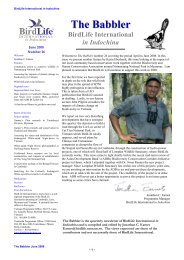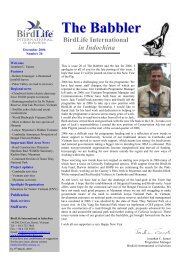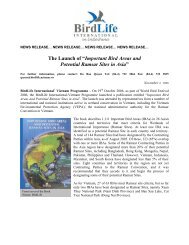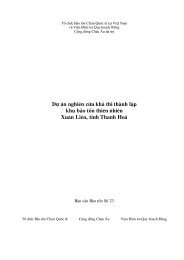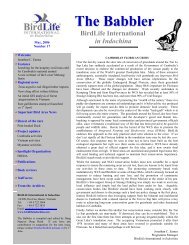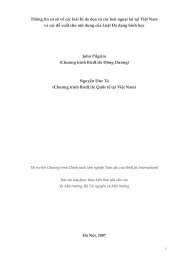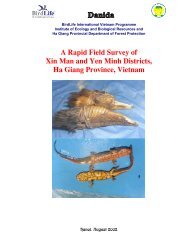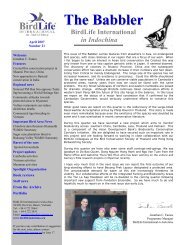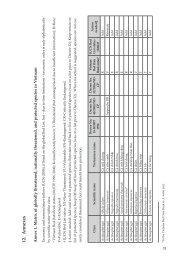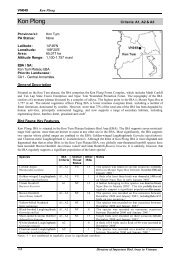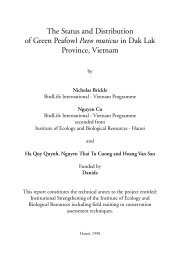Bird Life Tieng Anh-01.qxd - Birdlife International in Indochina
Bird Life Tieng Anh-01.qxd - Birdlife International in Indochina
Bird Life Tieng Anh-01.qxd - Birdlife International in Indochina
You also want an ePaper? Increase the reach of your titles
YUMPU automatically turns print PDFs into web optimized ePapers that Google loves.
8<br />
Conservation recommendations.<br />
•<br />
Raise awareness among all stakeholders of the biodiversity and socio-economic values of<br />
An Hai, and generate a sense of responsibility for the conservation of the site among the local<br />
community.<br />
• Control hunt<strong>in</strong>g by means of appropriate prov<strong>in</strong>cial, district or commune-level regulations,<br />
comb<strong>in</strong>ed with tra<strong>in</strong><strong>in</strong>g and appropriate <strong>in</strong>centives for local communities.<br />
• Incorporate environmental considerations <strong>in</strong>to future aquacultural development plans.<br />
Changes s<strong>in</strong>ce 1996. There has been widespread conversion of habitat s<strong>in</strong>ce 1996, with significant<br />
loss of mangrove and, on D<strong>in</strong>h Vu island, loss of a large reedbed of Phragmites sp. <strong>in</strong> the north and<br />
construction of an <strong>in</strong>dustrial harbour.<br />
The site cont<strong>in</strong>ues to be important for migrant waterfowl <strong>in</strong> autumn, despite the levels of hunt<strong>in</strong>g<br />
and other disturbance. Numbers of shorebirds appear to have decl<strong>in</strong>ed (maxima of 1,400 <strong>in</strong> 1996,<br />
but only 900 <strong>in</strong> 2006), whilst gulls Larus sp. cont<strong>in</strong>ue to frequent the mudflats <strong>in</strong> small numbers<br />
(up to 1,000 reported <strong>in</strong> 1996) (Pedersen and Nguyen Huy Thang 1996).<br />
4.2 Tien Lang<br />
Relative importance of site: Ranked 4 (10 po<strong>in</strong>ts)<br />
Prov<strong>in</strong>ce(s): Hai Phong<br />
Protected Area status: None<br />
Latitude: 20º39’N<br />
Longitude: 106º39’E<br />
Area: 5,000 ha<br />
Altitude Range: 0–2 m asl<br />
Important <strong>Bird</strong> Area (IBA): VN015<br />
General Description. Tien Lang has 13 km of coastl<strong>in</strong>e stretch<strong>in</strong>g from the Thai B<strong>in</strong>h Estuary <strong>in</strong><br />
the south to the Van Uc Estuary <strong>in</strong> the north. Each estuary has approximately 100 ha of old-growth<br />
mangrove, largely enclosed with<strong>in</strong> aquacultural ponds, and extensive <strong>in</strong>tertidal mudflats with two<br />
<strong>in</strong>tertidal sandy islands <strong>in</strong> the Thai B<strong>in</strong>h Estuary (one <strong>in</strong> Hai Phong city, the other <strong>in</strong> Thai B<strong>in</strong>h<br />
prov<strong>in</strong>ce). To the south, the site borders Thai Thuy IBA (VN014) (Nguyen Duc Tu and Le Trong<br />
Trai 2005, Pedersen and Nguyen Huy Thang 1996).<br />
Status. Although the area stretch<strong>in</strong>g from the Diem Dien River, Thai B<strong>in</strong>h prov<strong>in</strong>ce, to the Van Uc<br />
River, Hai Phong city, cover<strong>in</strong>g the Thai B<strong>in</strong>h Estuary <strong>in</strong> Thai Thuy and Tien Lang districts and<br />
the Van Uc Estuary was proposed as a nature reserve <strong>in</strong> 1996 and a nature reserve <strong>in</strong>vestment<br />
plan prepared, the precise boundaries of the proposed 5,000 ha reserve have not been def<strong>in</strong>ed. No<br />
<strong>in</strong>vestment plan has been prepared, nor is it <strong>in</strong>cluded on the list of Special-use Forests to be established<br />
by the 2010, prepared by FPD of MARD. The site is currently under the management of Tien Lang<br />
District People’s Committee (Tordoff et al. (eds.) 2004).<br />
Vegetation. Natural vegetation comprises ma<strong>in</strong>ly Sonneratia caseolaris, Bruguiera gymnorrhiza,<br />
Aegiceras corniculatum, plus some Acanthus ilicifolius ma<strong>in</strong>ly <strong>in</strong> the Thai B<strong>in</strong>h Estuary, and a few<br />
Kandelia candel and Avicennia latana. On estuaries, S. caseolaris dom<strong>in</strong>ates with 5–6 trees/m 2 ,<br />
many of them up to 7 m tall, and 15–20 cm <strong>in</strong> diameter. The understorey is ma<strong>in</strong>ly B. gymnorrhiza<br />
and Aegiceras corniculatum, whilst Acanthus ilicifolius is ma<strong>in</strong>ly at the mangrove marg<strong>in</strong>s. In canals<br />
near the estuary, mangrove comprises S. caseolaris, B. gymnorrhiza, Aegiceras corniculatum,




